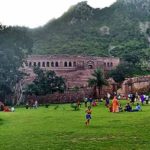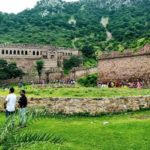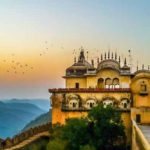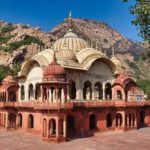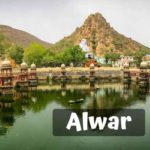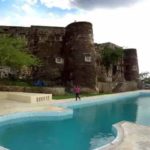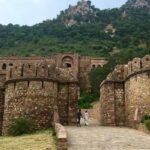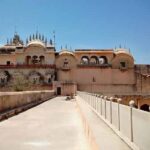Top 10 Tourist Places in Alwar is popular for many tourist places and before visiting them, we have shown them in the list here in this article to give you an idea. The Alwar was founded in 1170, by Raja Pratap Singh, a Rajput king of the Kachwaha lineage. The first Rajputana state (now known as Rajasthan) to conclude an offensive and defensive treaty with British rulers was Alwar. It later became a city under the newly created State of Rajasthan.
Alwar Fort / Bala Quila, Moti Doongri, Bhangarh Fort, Maharani Ki Chhatri, Hill Fort Kesroli, Itarana, Vijay Mandir, Jaisamand Lake, and Sariska Tiger Reserve, among many others, are popular tourist places in Alwar. There are also many gardens where tourists can have a pleasant time and Alwar is a place where people from many other communities stay here, but not only Rajasthan is here, so during your tour of Alwar Tourist Places you can see many ethnicities in culture.
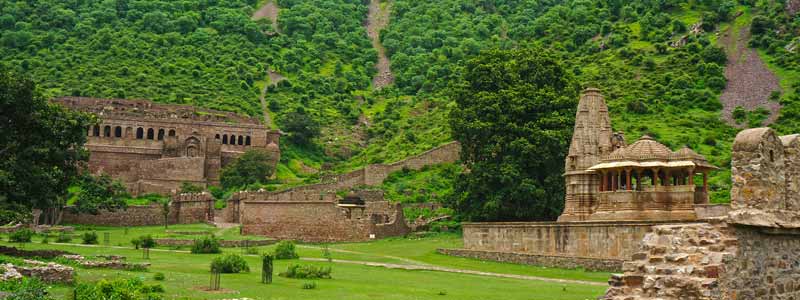
Bhangarh fort
Bhangarh Fort is one of Rajasthan ‘s mediaeval forts, located in the Alwar district of Bhangarh town.
During the rule of Bhagwant Das, the town of Bhangarh was founded in 1573. In 1613, Madho Singh, who was the son of Man Singh of Amber, a great Mughal general, constructed the Bhangarh fort. One of the most haunted locations in India is known to be the fort. Villages have sprung up far from the fort because of the various ghostly encounters and happenings in the fort premises. Locals and visitors have been banned from entering the fort at night by the Archaeological Survey of India.
It is assumed that the fort and the town of Bhangarh have been haunted for many years. The palace has many storeys associated with it. The town was cursed, according to one storey, by a sorcerer, Guru Balu Nath, who sanctioned the building of the town on the condition that the town be demolished as soon as the shadow of the palaces reached it. Ajab Singh, son of Madho Singh, lifted the height of the palace in ignorance, causing Bhangarh to be devastated. To this day, Balu Nath is said to be buried in a small Samadhi there. A tantrik who fell in love with the princess of Bhangarh, Ratnavati, cursed the entire region to be ruined, as per another myth.
A ruined wall surrounds Bhangarh Fort, now in ruins. Lahori Gate, Ajmeri Gate, Phulbari Gate, and Delhi Gate have four entrances. There is a Dancer’s Haveli and Jauhari Bazar inside the fort. Lord Someshwar, Gopinath, Mangala Devi and Keshava Rai ‘s natural springs, waterfalls, parks, havelis, banyan trees and temples can also be found in the fort. There is also a secluded chhatri, atop an elevated hill overlooking Bhangarh ‘s town and fort.
The Archeological Survey of India has installed a board on the fort gate that, after sunset and before sunrise, it is forbidden for tourists to remain inside the fort area.

Sariska Wildlife Sanctuary
The Wildlife Sanctuary of Sariska is located just 200 km from Delhi and 107 km from Jaipur. It is less commercialised, though larger than Ranthambore, and has less tigers but a similar topography. In total, it occupies an area of 800 sq km, with a core area of around 500 sq km.
With their mixture of sharp cliffs and deep , narrow valleys, the Northern Aravali Hills dominate the skyline. In 1955, the area was proclaimed a sanctuary and became a National Park in 1979.
Sariska ‘s landscape consists of the Aravali hill range’s hills and small valleys. Sariska ‘s topography supports arid scrub-thorn trees, dry deciduous forests, rocks and herbs. A wonderful example of ecological adoption and tolerance is the wide variety of wildlife here, since the climate here is both unpredictable and volatile.
The landscape of Sariska, whose forests are dry and deciduous, dominates the steep cliffs of hills and narrow valleys of the Aravallis. The ruins of the mediaeval temples of Garh-Rajor, from the 10th and 11th centuries, are situated within the Sariska wildlife sanctuary.
On a steep hilltop at Kankwari, a 17th-century castle offers a panoramic view of flying Egyptian vultures and eagles. In 1955, the area was proclaimed a sanctuary and became a National Park in 1979.
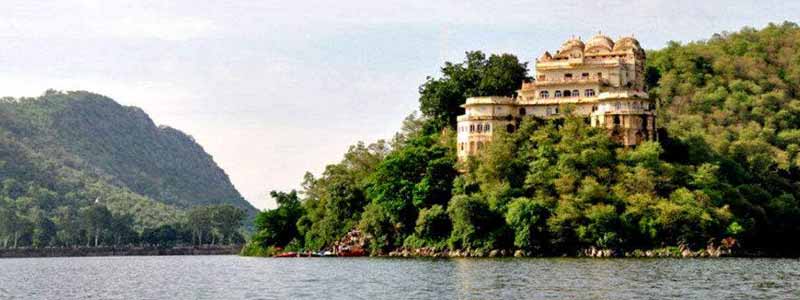
Siliserh Lake Palace
Siliserh Lake and Palace is located on the road from Alwar to Sariska. Siliserh Lake Palace was constructed for her beloved wife Sila by Maharaja Vinay Singh of Alwar in 1845. The lake and reservoir built by Maharaja was the town of Alwar’s main source of water.
Over an area of 10.5 square kilometres, the majestic Siliserh Lake near the Palace spreads out and forms the backdrop of the Siliserh Palace, which has now been converted into a heritage hotel. There are a host of domed cenotaphs in Siliserh Lake and it is circumscribed by the majestic slopes of the range of Aravalli. To collect the waters of a small tributary of the River Ruparel in the Lake, two earthen dams were built.
Siliserh Lake ‘s location is picturesque and it is home to a large number of migratory birds. Significant numbers of tourists visit the serene lake for boating, sailing and fishing. Here, there are various kinds of boats available. Hotel Lake Palace provides royal suite AC and non-AC rooms with all luxury amenities, well furnished as a royal one. It has a restaurant serving delicious cuisine of Continental, Indian and traditional Rajasthani.
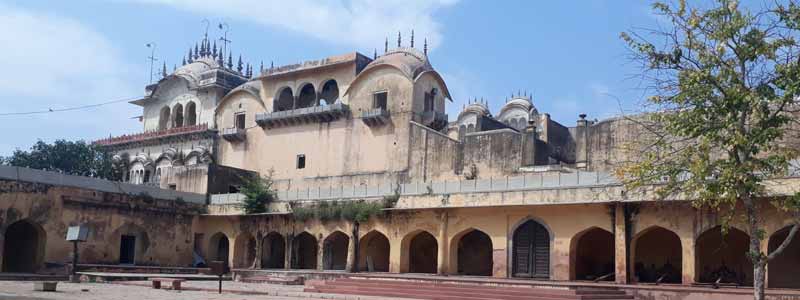
Bala Quila
In the state of Rajasthan, Bala Quila, also known as Alwar Fort, is a big fort in Alwar. It is situated 300 m above the town of Alwar on a hill in the Aravalli Range.
Alwar ‘s oldest structure is Bala Quila, meaning the young fort. In 1550 AD, it was constructed by Hasan Khan Mewati. It went into the possession of the Mughals, Marathas, Jats and Kachwaha Rajputs in the centuries that followed. The Mughal emperor had spent a night here, Babur, and had also taken away a large amount of treasure to send his son, Humayun. Later, when his father, Akbar, was banished for planning to kill one of his courtesans, Abul Fazal, Jahangir remained there for some time. The place where he was staying was called Salim Mahal. It was captured by Kachwaha Rajput Pratap Singh in 1775 AD and the base of Alwar town was laid.
The fort has a length of 5 km and a width of around 1.5 km. There are 6 gates to the Fort, namely Jai Pol, Laxman Pol, Suraj Pol, Chand Pol, Andheri Gate, and Krishna Gate. There are 15 large and 51 small towers in the fort, which are surrounded by 8 massive citadels. The walls of Bala Quila are decorated with finely designed ancient sculptures and scriptures, constructed in a traditional Indo-Islamic style of architecture. Many other impressive structures are also housed in the fort, such as Nikumbha Mahal Palace, Suraj Kund, Salim Sagar Pond, Jal Mahal and 15 striking temples, including the Chakradhari Hanuman Temple and the Sita Ram Temple. Each structure inside the fort, surrounded by the majestic Aravalli Hills, represents the opulence of the past period , particularly the Nikumbha Mahal Palace, which is constructed with wide latticed balconies using Bengal caned marble pillars.
Bala Quila is in dilapidated condition now and the radio transmission station is housed there. The immense gates, arches and battlements can still be seen.
City Palace Alwar
The City Palace of Alwar is a wonderful building in the centre of the city of Alwar. Established at the end of the 17th century, a fine example of Rajput-Islamic architecture is the City Palace. The architecture of the majestic palace, a widely visited landmark in Alwar, speaks clearly of its gates of entry. It is possible to enter the Palace through different gates, known as Laxman Pol, Suraj Pol, Chand Pol, Kishan Pol and Andheri Gate. One is likely to come across an open field with Krishna temples on all sides once you have passed through these gates.
The City Palace, well known for its heritage and archaeology, also houses a museum that preserves the rich history of the Palace. The miniature paintings of the historic Alwar Academy, which adorn the walls of the prestigious museum, are fascinating. There is also a golden Durbar hall, which is one of the highlights of the Alwar City Palace, in addition to the museum.
Moosi Maharani Ki Chhatri
Arranged outside Alwar’s main royal residence, it was run by Vinay Singh in memory of the ruler of Alwar, Maharaja Bakhtawar Singh, and his ruler, Rani Moosi, who gave ‘sati.’ The tomb of the lord and the king is protected by this excellent cenotaph and the entire chhatri is upheld by pillared sandstone. Chhatris are commonly used in the Rajput engineering of Rajasthan to represent the components of pride and reverence. This striking landmark is set outside the basic royal residence palace, the imperial cenotaph of Maharaja Bakhtawar Singh and his Queen Rani Moosi. It is a lovely red sandstone and white marble cenotaph of Alwar ‘s founders.
Pandu Pol alwar
One of the most visited places in Sariska is the Hanuman Temple of Pandupol, situated within the Sariska National Tiger Reserve of Rajasthan. At Pandupol or Pandu Gate, an enchanting spring emerges from hard and compact rocks. A massive idol of Lord Hanuman is enshrined in the Hanuman Temple here. Waterfalls can be seen at this location during the rainy season, and birds of different kinds can also be seen. Langurs and macaques can be seen in the temple premises as well. The temple is located 60 km away from Alwar City.
This temple adds more charm to its simple architecture and beautiful location. This ancient temple is one of the most visited tourist places in Alwar, situated within the lush green surroundings of Sariska National Park and Tiger Reserve. Pandupol temple portrays its tourists with a genuine mix of nature, architecture and culture.
In Sariska Alwar, the Pandupol temple is dedicated to Lord Hanuman. Lord Hanuman is believed to be the God of extreme strength, tremendous strength, and the most powerful of all warriors. Because of this reason, Lord Hanuman is one of the most respected god figures in Indian religion, according to Lord Hanuman’s devotees, dispels all fears and spirits. All Hindus worship with pure devotion and reverence the holy shrine of Pandupol because they believe that Lord Hanuman will protect their family with all kinds of supernatural forces and evil spirits. All Hindus worship the holy shrine of Pandupol with pure devotion and reverence because they believe that Lord Hanuman will protect their family with all kinds of supernatural powers and powers.
It is said that the temple of Hanuman was established by Sant Nirbhaya Dassji Maharaj, who was a devotee of Lord Hanuman and thus established this temple of Hanuman ji in this thick forest, which is now completely developed and attracts thousands and thousands of people. Located in the middle of the Sariska Game Century, the place has a special charm. Every Tuesday and Saturday, people visit the temple in large numbers because Lord Hanumanji is kept sacred for these two days.
Bhartrihari Temple
In Alwar, the nearest town to the Sariska National Tiger Reserve, Bhartrihari Temple is situated. The temple, which is located about 30 km from Alwar, is dedicated to Yogi Bhartrihari Nath, one of Rajasthan’s most respected spiritual leaders. This temple, above the samadhi of Yogi Bhartrihari Nath, is built in the typical Rajasthani architectural style.
A Brahman lived in his state when Bhartrhari was king of ‘Ujjayani‘ (modern day Ujjain), who was granted the fruit of immortality from the celestial tree of Kalpavriksha after years of austerity. The Brahman offered the same thing to his monarch, Raja Bhartrhari, who, in turn, passed it on to his beautiful love, Pinglah Rani or Ananga Sena (as per Maha Kavi Kalidas), the last and youngest wife of Raja Bhartrhari. The queen was in love with the police chief.
He later became a Pattinathar disciple (Swetharanyar or Pattinathu chettiyar is poorvashram name of this Poompuhar saint, Tamil Nadu) who first indulged in an argument with King Bhartrhari about samsari and sanyasi later during the pattinathar conversation said that all women have ‘dual mind’ and it could be the real case also with parameswari. King transmitted this news to Rani Pingalah and ordered Pattinathar to be punished and to sit in ‘kalu maram’ (Wood, whose top portion will be sharpened like a pencil and the entire wood is fully painted with oil, individual who is permitted to sit in the top would be divided into 2 pieces), they tried pattinathar, but kalu maram began to burn and Pattinathar did not happen anything, This news came to the king, and he went straight to Pattinathar and asked him to get ready to die the next day, but Pattinathar replied that I was ready to die even now. The king came the next day with tears in his eyes and released the saint from prison because that night he actually saw queen pingalah in love with horsemen, threw away his kingdom, riches, even his full dress coat, and dressed in a plain kovanam (loin cloth).
Naraini Mata Temple
The Narayani Mata Temple is approximately 80 km from Rajasthan’s main city of Alwar and 14 km from Amanbagh. It is situated on the edge of the popular national park of Sariska.
Its sanctity is close to the temples at Mount Abu, Pushkar and Ramdevra, the only temple of Saint Samaj in India. Narayani Mata is believed to be the location where the first sati (fire immolation) incident took place prior to Rani Sati. As per the myth, Narayani went to her in-laws with her husband after marriage. Her husband had been bitten by a snake on the way, and was dead. She was profoundly saddened and prayed to Lord Shiva, sitting next to his unlit funeral pyre, to give him his life back or permit her to commit sati with her dead husband. Lord Shiva, who sent a holy fire to destroy both of them, answered her prayers. Both Rani Sati and Narayani Mata are the same according to local beliefs. Nearby, there is a holy spring that brings beauty to the temple.
At this temple, Baniyas (Agarwals) are not permitted. There is a priest from the Meena caste. Every year before 1993, there used to be a major fair organised by the locals at the temple site that was banned by the late Mr. Rajeev Gandhi, who was the prime minister at that time to ban ‘sati’ in the country. You may visit this holy place and have a tea break en route to the ruins and fortress of Bhangarh.
Vijay Mandir Palace
The town of Alwar has retained Rajasthan’s culture and traditions in its temples, markets, festivals, etc. The meaning of Rajasthan’s mud lingers in Alwar. Vijay Mandir Palace, which is located about 10 km away from Alwar, is one of the beauties of Alwar. Visit Vijay Mandir Palace, which was designed by Maharaja Jai Singh and is an extremely beautiful palace. Everyone is bewitched and awestruck by the mesmerising elegance of the palace. The palace stands humming the ode of grandeur and grandeur of the rulers of Rajasthan and its culture from the Royal period.
There is a fascinating tale about the Palace of Vijay Mandir. The palace was constructed after Maharaja Jai Singh rejected the construction of Yashwant Nivas. It is said that Yashwant Nivas was not happy with Maharaja Jai Singh. After its completion, it did not come out as his project. That prompted the king to start building the Vijay Mandir Palace immediately. And the outcome is before all. The unrivalled elegance of the palace ‘s beauty leaves us spellbound. Within, the palace houses 105 artistically elegant rooms. The architecture of this huge palace is brilliant. Every intricate detail seems to have been accomplished by taking proper care. Any engineer of this age will contend for the alignment of the massive pillars and the measurement of all arches and designs.
India’s Vijay Mandir Palace is a beauty to adore. Its location in front of Vijay Sagar lake is what makes it more enchanting. The palace appears to be the same as in the fairy tales you used to read. The palace appears to be peaceful and serene, surrounded by a mesmerising landscape. It has become Alwar Vijay Mandir Palace ‘s biggest tourist location. The Sita Ram Temple, which is inhabited by a large number of people, is another aspect of beauty in the palace Tourists and devotees during Ramnavami. But without permission, no one is permitted to enter the palace, one has to obtain permission to enter the palace from the maharaja of Alwar.

